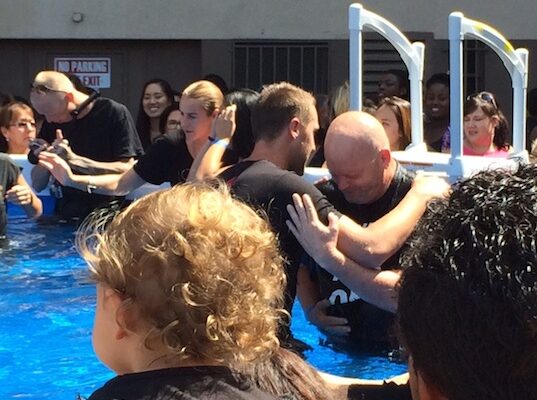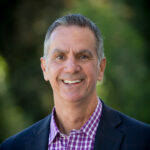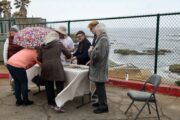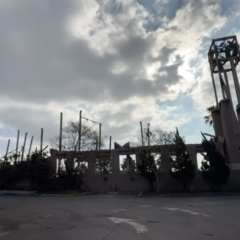I’m churched out. I’ve gone to more church services in the last two months than I have over the past 30 years. Now, I’m not exactly complaining about this development since these have been, almost without exception, great experiences. It’s wonderful to meet and talk with people I would otherwise never come to know.
The services I’ve attended have varied significantly. I’ve been to some mainline Protestant services that look and sound evangelical, and to others that feature experimental, stripped-down liturgies; to LGBT congregations that also have “straight” members; to congregations that are intentionally diverse both ethnically and economically and that are committed to being a positive and hopeful presence in their communities. Services have been held in art galleries, theaters, on street corners and in actual church buildings. In every instance both members and leadership have greeted me warmly, even though they often have no idea who I am or why I might be there.
I’ve written elsewhere that while there are a many reasons people go to church, only one of those reasons has to do with “religion” per se. In my case, I’ve been visiting and participating in many different services as part of my work, but that hasn’t kept me from being drawn into the worship experience and community feeling of each of these congregations.
What has struck me most about these services is that in almost every instance, at some point I have been emotionally drawn into what was going on, whether by the music or some portion of the liturgy, or just by the way the members of the worshipping community interact with each other and with me.
For example, on my first visit to Founders Metropolitan Community Church, the weekly communion celebration really showed me who the members of that Christian community are and how they care for each other. At Founders, pastors and lay leaders distribute the usual Eucharistic elements to those who walk to the altar receive them. But what really got to me was the way that the pastors and lay leaders embraced each individual as he or she approached, and the extended time of prayer offered for each person while they were enveloped in the post-Eucharist embrace. There was no sense of urgency to finish the ritual in order to get to the next person; rather, this was a time of deeply human (and perhaps transcendent) contact for each person.
I’ve observed similar moments at other churches, illustrating to me the importance that these congregations place on tangible demonstrations of their care, concern and support for each other.
Similarly, the way that music is utilized in these churches is an important part of the worship atmosphere. In my case, music almost invariably produces an emotional response (yes, I tend to tear up during certain combinations of lyrics and melody). Yet I was surprised at one church when I saw that the old pipe organ wasn’t just being used to evoke nostalgic “churchy-ness” but was actually being played by a real organist! This was, in a strange way, very emotional for me. It brought back memories of growing up in churches where my mother was the organist. As a young child, I often sat at her feet while she played during the service.
Most recently I attended a baptism service at one of the city’s newest churches, Hillsong L.A. Hillsong meets at the Belasco Theater in downtown, and if Hillsong is anything (and I believe it is much more than this) it is an impressively polished performance involving worship, music and preaching, with upwards of 1,000 mostly younger people in attendance at each service.
The baptisms took place after the 11:00am Sunday service in the parking lot adjacent to the theater, and included two gourmet food trucks, places for people to talk, a stage and a worship band—along with an above-ground pool in which several dozen people were baptized. It all unfolded in the shadow of the Los Angeles skyline, with lots of family and friends cheering on each person and the occasional homeless person walking through the crowd and asking for “a little help.” To see the sheer joy on the faces of individuals as they came up out of the water, and to hear the hoots and hollers of support from their family and friends, was a very touching experience.
Of course these moments could easily be dismissed as so much nostalgia about my childhood, simpler times or whatever. But I think there is something else going on that helps explain my involuntary reactions to this range of church experiences. We are cumulative beings; that is, we are not only who we are in a particular moment, but the accumulation of different experiences, relationships, associations and the like, all of which work together to make us who we are.
I’ll hasten to add that I’m no psychologist, so I will refrain from any further attempts to explain human consciousness. But my point is that in each of these experiences—and in similar experiences in other religious traditions—there is some amalgam of memory and desire that often resonates with the ritual environment to produce a deep emotional and somatic response. This has certainly been the case in my visits to these different churches.
In my view, consistently successful congregations are those that are able to provide just this sort of emotional and somatic resonance, something that I think we all crave. Creating this spiritual alchemy takes creativity, skillful communication and a willingness to take some measure of risk—the essential ingredients of innovation. It’s important to note that these moments of authenticity can’t be produced through contrivance or manipulation. Like its counterpart in other realms, true spiritual innovation can’t be faked. You know it when you see it.
Richard Flory is the executive director of the USC Center for Religion and Civic Culture.








